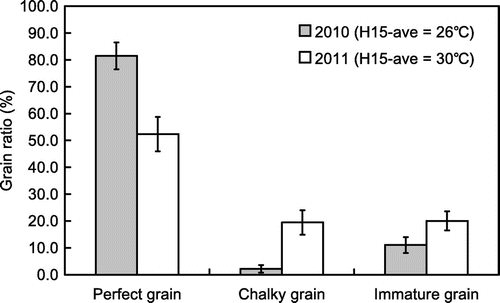Abstract
Typical japonica type rice is sensitive to high temperature. Pon-Lai rice is a special japonica type with adaptation to the subtropical climate in Taiwan. Facing climate change, rising temperatures would damage the yield and quality of rice production. This research was conducted using Pon-Lai rice in the field of a subtropical climate. We conducted 2 experiments, including a year-round experiment and collection of samples from different districts for building different temperature conditions. We analyzed the correlation between rising temperature and rice yield or quality. In our results, the critical period of temperature effect is 0–15 days after heading (H15). The threshold of high temperature damage in yield and appearance quality was 25–27 °C. Grain weight decreased about 2–6%, while the temperature of H15 was raised 1 °C above the thresholds. Perfect grain ratio and chalky grain ratio decreased and increased, respectively, while the temperature of H15 was raised above the thresholds. However, the high temperature in H15 affected the physicochemical characteristics. In addition, we found positive correlation between grain length to width ratio and perfect grain ratio. Grain length to width ratio could be an index of temperature effects for grain quality. In our study, when the temperature was below 30 °C, a rising temperature of H15 could damage rice yield and appearance quality, and change grain shape. Our results could provide reference for dealing with the warming future in other temperate rice-cultivated countries.
1. Introduction
Taiwan located in subtropical Asia with relatively high temperatures and long-day photoperiods. Native people cultivated the indica type rice until the 1900s. After the 1900s, the Japanese began ruling Taiwan and brought japonica type rice. However, japonica type rice was always grown in temperate climate with cool temperatures and short-day photoperiods. Typical japonica type rice cultivars, which were introduced by the Japanese and grown in Taiwan, would encounter dwarf plant height, few tillers, extremely short life cycle, and consequent yield damages. Accordingly, the Japanese spent many decades attempting new-cultivar breeding from traditional japonica type cultivars and native cultivars. Finally, special japonica type cultivars, called “Pon-Lai rice”, which were adapted to the subtropical climate, were developed (Chang, Citation1999, Chapter 2). In the high temperature of a subtropical climate, Pon-Lai rice maintains healthier growth conditions and higher yield components than typical japonica type rice (Chang, Citation1999).
IPCC-AR4 forecasted that global temperatures will increase by 1.8–4 °C by the end of this century (IPCC, Citation2007). Many studies have discussed the impacts to japonica type rice by rising temperature. High temperatures would induce sterility and lead to low harvest index and grain yield (Jagadish et al., Citation2007; Oh-e, Saitoh, et al., Citation2007; Prasad et al., Citation2006). High daily maximum temperatures would inhibit dehiscence and germination of pollen grain (Matsui et al., Citation2001; Zhao et al., Citation2010) and pollen production (Prasad et al., Citation2006). High nighttime temperatures or daily minimum temperatures would reduce the germination percentage of pollen grain and repress spikelet fertility (Mohammed & Tarpley, Citation2009). Therefore, daily maximum and minimum temperatures both play important roles in grain fertility. In addition, grain appearance quality was affected by high temperature. In high temperatures, the shortened grain filling period and high filling rate would raise immature and chalky grains percentage (Huang & Lur, Citation2000; Kobata & Uemuki, Citation2004; Tsukaguchi & Iida, Citation2008), while the formation of chalky grains was most sensitive to high temperatures during the period of 12–16 days after heading (Tashiro & Wardlaw, Citation1991b). At the molecular level, various reports, including our previous studies, have shown that high temperatures could change gene expressions for amylose and storage protein accumulation, and further affect taste quality (Lin et al., Citation2005; Lin et al., Citation2010; Yamakawa et al., Citation2007). In addition, the formation of a chalky appearance might be related to the expressions of small heat shock proteins (sHSP) and stress regulatory proteins during the grain filling stage (Lin et al., Citation2010; Yamakawa et al., Citation2007).
Taiwan is an area with the hottest climate in the cultivation areas of japonica type rice (Lur et al., Citation2006), and there would be more than +1 °C increases in nighttime temperatures in the main rice production area of Taiwan (Shiu et al., Citation2009). That is, Taiwan is an adequate location for the research of rice cultivation in the warming future. This study used heat-tolerant Pon-Lai rice to conduct year-round experiments in order to identify yield and quality effects in different temperatures. Therefore, we determined the cultivation period with the best temperature conditions for good agricultural practices (GAP), as based on the correlations between grain yield or quality and cultivation temperature. In addition, our results presented a yield-to-temperature or quality-to-temperature index, which could provide reference for building a weather-based crop yield index, as well as crop insurance (Chavula & Gommes, Citation2006) for upcoming climate change.
2. Materials and methods
2.1. Plant materials
Taiwanese japonica type rice (Pon-Lai rice): Taikeng 9 (TK9) is the major ‘good quality rice cultivar’ in Taiwan and was chosen for this research. TK9 is from crossing Hokuriku 100 (as mother) and Tainung Sen breed 2414 (as father). Hokuriku 100 is a γ-ray-mutagenesis variety of Koshihikari (a Japanese cultivar with high quality). Tainung Sen breed 2414 is a selected descendant of IR5470 (an indica type rice with good heat tolerance). Accordingly, TK9 has good quality in the subtropical climate of Taiwan (Taiwan Agricultural Research Institute, Citation2004).
2.2. Growth conditions
There were two parts of field experiments during 2007 and 2008 in this research. Experiment 1 was conducted at the Miaoli District Agricultural Research and Extension Station farm at Gongguan, Miaoli, Taiwan (24°29′N, 120°49′E). Two year-round cultivation experiments with 8 and 9 cultivation periods were conducted in 2007 and 2008, respectively. In 2007, the 8 cultivation periods were transplanted on 8 March, 27 March, 2 April, 12 April, 30 April, 15 June, 2 August, and 21 August. In 2008, the nine cultivation periods were transplanted on 28 February, 7 March, 18 March, 28 March, 7 April, 17 April, 7 May, 19 July, and 7 August. Three-to-four-leaf-aged seedlings were transplanted at the rate of one seedling per hill at a spacing of 30 cm × 15 cm. There were three replications of each culture period. Each replication plot was 3.0 m × 4.0 m in size. In cultivation, phosphorus (54 kg ha−1 as P2O5) and potassium (48 kg ha−1 as K2O) were applied 1 day before transplanting. Fertilizer N was applied four times (48 kg ha−1 as ammonium and urea at 1 day before transplanting, 40, 20, and 20 kg ha−1 as ammonium at 20, 40, and 60 days after transplanting, respectively). Grain samples were collected 18 hills per replication when only 2–3 green grains were on the basal of panicles.
Experiment 2 was conducted at 6 rice cultivation districts, including Taoyuan (24°56′N, 121°01′E), Miaoli (24°29′N, 120°49′E), Taichung (24°00′N, 120°32′E), Chiayi (23°29′N, 120°28′E), Tainan (23°03′N, 120°20′E), and Taitung (22°50′N, 121°04′E). This experiment was conducted at the 2nd cropping season of 2007. Cultivation management, including fertilization, harvest timing, and sample collection, was the same as experiment 1.
In addition, for proving the high temperature effect on rice appearance quality, we collected rice quality data (including perfect grain ratio, chalky grain ratio, and immature grain ratio) from the government in 16 paddy fields of tropical Taiwan in the 1st cropping season of 2010 and 2011. This study measured the three type grain ratio by visual inspection. Chalky grains account for over 1/2 of the grains with opaque or chalky appearance, while immature grains are stunted and broken grains (Council of Agriculture, Citation2008). Rice was transplanted in February and harvested in July in tropical Taiwan. Definite transplanting date, heading date, and harvest date were recorded. Samples were collected at 50 hills per field for rice quality analysis.
2.3. Analysis of temperature data
Daily temperature data of each district were collected from Central Weather Bureau. Then, the data were transformed to (1) accumulated temperature of whole cultivation period (T), (2) accumulated temperature after heading (H), (3) average temperature from 0–15 days after heading (H15-ave), (4) average daily maximum temperature from 0–15 days after heading (H15-max), (5) average daily minimum temperature from 0–15 days after heading (H15-min). Accumulated temperature was the sum of the daily mean temperatures. Heading date was identified as 50% panicles heading.
2.4. Post-harvest treatments of samples
Samples were threshed and air dried to a moisture content of 13.5–14.5%, and then, the grain weight per hill was measured. After that, grains were selected into fertile and sterile grains by a wind selection machine (Seedburo South Dakota Seed Blower, Seedburo, USA), and the fertility rate was measured. Fertile grains were husked to brown rice, while grains with <50% of normal size were sieved out in the husking process. Then, the brown rice was polished (85%) to polished grains.
2.5. Measurements of rice quality
For the efficient measurement of large amounts of samples from field experiments, this study used a machine to analyze rice quality. Polished grains were separated into perfect grains and chalky grains by a grain quality inspector (RGQI-20A, SATAKE, Japan), and computed grain length, width, length to width ratio, and perfect grain ratio and chalky grain ratio in grain numbers. In addition, polished rice was transformed to rice flour, and viscosity analysis was conducted for peak viscosity, breakdown, and setback by a viscosity analyzer (Rapid Visco Analyzer; Newport Scientific Pty. Ltd., Warriewood, NSW, Australia).
2.6. Statistics analysis
Correlation between temperature and data regarding grain yield or quality was established in a linear or binomial formula (according to adjusted R-square). P value and significance were analyzed by statistical software The ‘R’ (R Development Core Team, Citation2007), and P values of each formula were defined to significant correlation if the P value <.05, highly significant correlation if the P value <.01, and extremely significant correlation if the P value <.001.
3. Results
This research indicated many cultivation periods or cultivation districts with cool to high temperature conditions. Correlations between temperature conditions (including accumulated temperature and other items mentioned in previous section) and yield or quality traits (including fertility, grain weight, perfect grain, chalky grain, grain shape, and flour viscosity traits) was established in linear or binomial formula.
3.1. Temperature conditions
Temperature data were arranged and transformed into different forms (Table ). There are temperature conditions of 17 cultivation periods and 6 cultivation districts in Table . Experiments 1 and 2 covered temperature conditions including 2628.3–3435.3 °C-day, 661.5–1315.4 °C-day, 21.7–29.8 °C, 25.4–33.8 °C, and 16.6–25.4 °C as T, H, H15-ave, H15-max, and H15-min, respectively.
Table 1. Temperature conditions for the 2007 and 2008 year-round experiments (Experiment 1) and districts experiments (Experiment 2).
3.2. Yield traits
There were significant correlations between grain weight and H15-ave. (Figure (A)) The variation of grain weight became larger when H15-ave was above 28 °C. There would be higher risks of significant decrease in grain weight when H15-ave was above 28 °C.
Figure 1. (A) The relationship between grain weight per hill and H15-ave. And (B) the relationship between fertility and average (black circle), maximum (white square) and minimum (white triangle) temperature (Lur, Citation2009). **P value < .01. *Because the grains of the samples collected in 2007 of Experiment 1 were cracked in the process of polishing, we only used the samples from 2008 of Experiment 1 and samples from 2007 of Experiment 2 in this measurement. Equivalent sample numbers were used in measurements in Figure , Figure , and Figure .
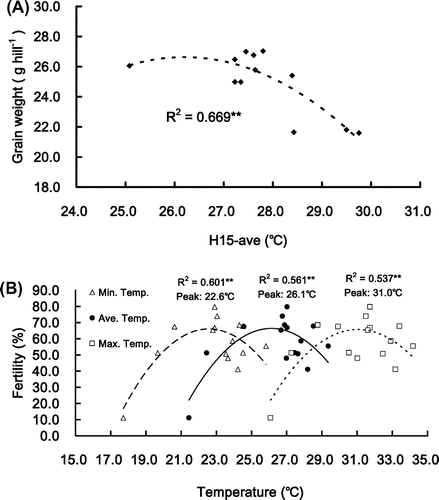
Fertility and grain weight were identified as yield traits in this research. There were highly significant correlations between fertility and temperature of heading week. Fertility increased with the rising temperature (including average, maximum, and minimum temperature), and decreased above temperature thresholds (Figure (B)). These thresholds of average, maximum, and minimum temperature were 25–27, 30–32, and 21–23 °C, respectively.
3.3. Quality traits
After analysis of correlations between temperature conditions and quality traits (appearance quality of polished rice and viscosity traits of rice flour), the P values of all matches are listed in Table . The results showed that there were significant correlations between the temperature of H15 and most quality traits. However, there were few correlations between accumulated temperature after heading and quality traits.
Table 2. P value of correlation between rice quality and temperature conditions.
There were extremely high significant correlations between H15-ave and perfect grain ratio or chalky grain ratio, and with <.01 in the P value (Figure ). The perfect grain ratio decreased, and the chalky grain ratio increased with the rising of H15-ave when it was above 25–27 °C. Regarding the aspect of grain shape, grain length decreased with temperature of H15 (P value <.01). However, there was no significant correlation between grain width and temperature of H15 (P value = .9). These resulted in a changing trend of grain length to width ratio, similar to the trend of grain length (Figure ).
Figure 2. The relationship between H15-ave and perfect grain ratio (black circle) or chalky grain ratio (white square). **P value < .01.
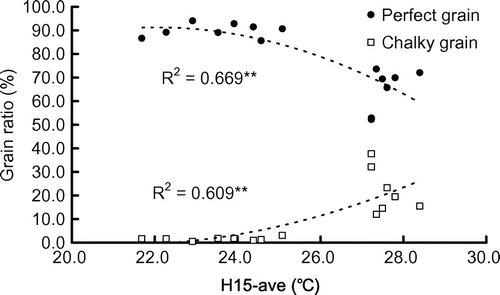
Figure 3. The relationship between H15-ave and (A) grain length; (B) grain width; (C) grain length/width ratio. **P value < .01.
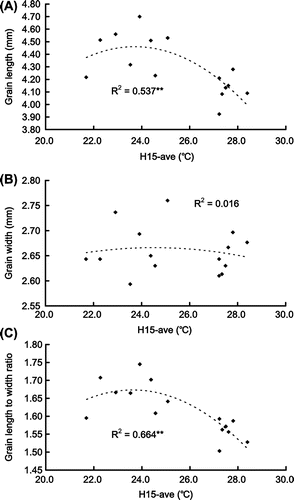
Regarding the aspect of viscosity, there were significant correlations between H15-ave and peak viscosity, breakdown, or setback (P values <.05, <.001, <.001 respectively). Peak viscosity and breakdown increased, while setback decreased with rising temperature (Figure ). There were significant positive correlations between peak viscosity or breakdown and taste score and negative correlation between setback and taste score (Liu et al., Citation2011). Higher peak viscosity referred good water swelling of the grains. Lower breakdown indicated softness in the cooked grain cooling period. Higher setback referred the more amylose content (Allahgholipour et al., Citation2006).
Figure 4. The relationship between H15-ave and RVA characters: (A) Peak viscosity; (B) Breakdown; (C) Setback. *P value < .05; ***P value < .001.
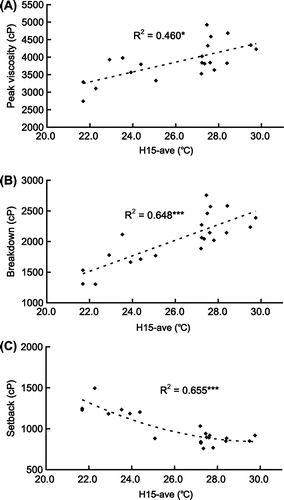
To verify the results of our experiments, we further investigated farmers’ field data and rice quality of the surveyed 16 farms in southern Taiwan in 2010 and 2011, as shown in Figure . H15-ave of the surveyed region was 26 and 30 °C in 2010 and 2011, respectively. In 2010, perfect grain ratio, chalky grain ratio, and immature grain ratio were 81, 2, and 11%, respectively, and 52, 19, and 20%, respectively, in 2011.
4. Discussion
In Taiwan, the temperature rises from January, and reached the highest point in July and August, and then, the temperature starts falling to the lowest temperature of December and January. Rice cultivation in Taiwan is separated into 2 cultivation seasons: 1st and 2nd seasons. In the 1st season, rice is transplanted in spring and harvested in early summer. Temperature is high in the reproductive period (June and July). In the closely following 2nd season, rice is transplanted in late summer and harvested in autumn. The environmental temperature of the reproductive period is contrary to the 1st season. The different temperatures in the reproductive period lead to different qualities of rice produced in the 1st and 2nd seasons. For example, in 2008, perfect grain ratio and chalky grain ratio were 53 and 32%, respectively, in the 1st season and were 91% and 3%, respectively, in the 2nd season. In fact, this kind of 2-season rice cultivation system (bimodal agriculture) is applied in many tropical countries, such as Thailand, Indonesia, Myanmar, Vietnam, and the Philippines (Canisius et al., Citation2007). Our results regarding differences in rice yield and quality between 1st and 2nd seasons could provide reference for these countries in cultivations in different seasons.
To cover a wider sample resource, we collected 6 different rice cultivation areas in Taiwan in 2nd season of 2007. Due to latitude, temperature is highest in Tainan and lowest in Taoyuan and Miaoli. In addition, there are cool summers and warm winters in Taitung. According to the cultivation period of each area, temperature condition was computed (Table ). Accumulated temperature after heading is highest in Taitung; however, the mean temperature here is not as hot, which is due to the longer period from heading to harvest (60 days). Radiation in Taitung is lower than other areas, which may prolong the grain filling period. The short grain filling period would increase the milky white rice kernels and damage grain quality (Kobata et al., Citation2011). That is, the low chalky grain ratio (<1%) in Taitung might be due to the prolonged grain filling period here.
By combining the results of experiments 1 and 2, regarding yield traits, when temperature is higher than 25–27 °C, grain yield will decrease by 2–6% with a 1 °C temperature increase (Figure A). As seen in a previous study, rice yield potential would decrease by 4.6–7.3% when the daily mean temperature raises 1 °C (Matthews et al., Citation1997). Tashiro and Wardlaw (Citation1991a) referred that high temperature did not repress grain yield until the daily mean temperature reached <26.7 °C. We also found in the heading week, higher temperatures (above threshold) will cause more sterility grains (Lur, Citation2009). The reason might be the lower activity of microsporocyte (Prasad et al., Citation2006), less pollen production (Matsui et al., Citation2005), and repression of stamen dehiscence (Matsui et al., Citation2005). High sterility decreases the final grain yield (Prasad et al., Citation2006). In addition, too high (daytime/nighttime temperatures were 32.8/31 °C) temperature might promote respiration (Long, Citation1991) and repress photosynthesis (Makino et al., Citation1994), which would lead to decreased sink, and cause a lower 1,000 grains weight.
Regarding appearance quality, the critical period of high temperature effects in rice appearance quality is 12–16 days after flowering (Tashiro & Wardlaw, Citation1991b). This period coincides with R6-R8 in the rice reproductive stage and is sensitive to environmental stresses (Counce et al., Citation2000). That is, if the rice encountered high temperatures during this period, the chalky grain ratio would increase significantly. This study analyzed the correlation between H15-ave and rice appearance quality. When H15-ave >25–27 °C, the perfect grain ratio decreased and the chalky grain ratio increased with the rising temperature, and the change range would be large in further high temperatures. Summing up the results, due to the significant effects of a rising mean temperature above 25–27 °C, we could set 25–27 °C as the threshold of grain yield and appearance quality. When the temperature was above the threshold, grain yield and appearance quality would decrease significantly due to a large amount of chalky grains, which may be due to the regulations of gene expressions for storage molecules and stress-responsive proteins during the early grain filling stage (Lin et al., Citation2005; Lin et al., Citation2010; Yamakawa et al., Citation2007). According to the results of practical field investigations of rice appearance quality from 16 farms in 2010 and 2011 by a district experimental station in Taiwan, the H15-ave in 2010 and 2011 were 26 °C and 30 °C, respectively, and the perfect grain ratios in 2010 and 2011 were 81% and 52%, respectively (Figure ). The field results could verify the correlation trend of Figure that a high H15-ave above 25–27 °C significantly decreases the perfect grain ratio, while increasing the chalky or immature grain ratio, and finally, damages appearance quality. Rice appearance quality is one of the standards for market rice pricing. The present results suggested that rice grains with poor appearance quality due to high temperatures may have low economic value, especially above the threshold of 25–27 °C. Based on this result, we may build yield-to-temperature or quality-to-temperature indices and provide reference for the development of agriculture insurance in the future, according to these climate indices.
Regarding the physicochemical properties of rice flour, we performed RVA measurement. The rice flour grown under high temperature showed higher peak viscosity, higher breakdown, and lower setback (Figure ). The change of RVA characteristics may be due to the influence of high temperature in the biosynthesis of amylose, amylopectin, and protein (Jiang et al., Citation2003; Lin et al., Citation2010). There were reports which indicated that taste quality was positively correlated with peak viscosity and breakdown (Liu et al., Citation2011; Shu et al., Citation1998). However, in this study, caution should be taken to correlate the changes of RVA characteristics with the taste quality of rice flour grown under high temperatures. Matsue (Citation2007) indicated that high temperature would damage taste quality. When the temperature of the grain filling stage was above 26 °C, the taste scores of two Japanese cultivars would be worse with the rising temperature. Many other studies showed trends similar to Matsue (Citation2007) (Ishizuki et al., Citation2013; Oh-e, Matsue, et al., Citation2007). Therefore, the changing trend of RVA traits could not be used as a comprehensive index of the taste quality of rice flour grown under high temperatures. As our results only provide a preliminary reference, the relationships among the changing trends of RVA traits, palatability, and even human sensory testing must be clarified in the future.
In the quality traits results of this study, Pon-Lai rice seemed to be more tolerant to high temperature than the typical japonica type rice. In the face of the warming climate trend, these kinds of cultivars might be able to become the breeding materials for other rice-cultivating countries with temperate climates.
Many previous studies revealed that high temperature would decrease grain length (Mohammed & Tarpley, Citation2010) or grain width (Counce et al., Citation2005), and the decreased length or width might be one of the reasons for low yield under high temperatures (Counce et al., Citation2005; Morita et al., Citation2005). Furthermore, the changing degrees between grain length and grain width were usually different (Counce et al., Citation2005; Huang et al., Citation2013; Mohammed & Tarpley, Citation2010); thus, length to width ratio of rice grains might be changed under high temperatures. Previous study also indicated that there were negative correlations between grain shape (length to width ratio) and rice quality characters, according to the measurements of different rice cultivars (Luo et al., Citation2004). We analyzed the correlation between grain shape and appearance quality. The appearance quality (perfect grain ratio) increased along with the increase in grain length to width ratio (Figure ). The higher chalky grain ratio might be related to the lower grain length (lower grain length to width ratio) when H15-ave increased above 24 °C (Figures and ). It is worthy of further study to identify the physiological and genetic rationale for the correlation between grain shape and grain quality, and whether grain shape can be used as an index for grain appearance quality under high temperature climate.
Figure 6. The relationship between grain length/width ratio and perfect grain ratio (black circle) or chalky grain ratio (white square). *P value < .05; **P value < .01.
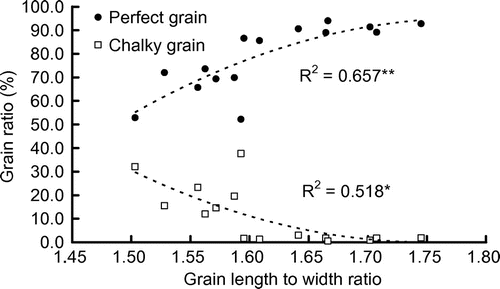
This study focused on the application of field experiments. By adjusting the cultivation periods, we hoped determine the best temperature environment for high yield and quality rice. However, advancing or postponing the cultivation period might encounter some risks, such as cold stress, typhoon, or bird damage; thus, growers should assess these risks before adjusting the cultivation period. Concluding our results, H15-ave significantly affected rice yield and quality. High H15-ave would change the yield, grain shape, appearance quality, and flour viscosity traits. Our results could provide reference for the development of GAP for high-quality japonica type rice in the warming future.
Notes on contributors
Yi-Chien Wu ([email protected]) is currently a PhD student in the Department of Agronomy, National Taiwan University. He also works as a assistant researcher in the Taichung District Agricultural Research and Extension Station, Taiwan.
Su-Jein Chang ([email protected]) is an experienced rice breeder in the Miaoli District Agricultural Research and Extension Station.
Huu-Sheng Lur is a professor in the Department of Agronomy, National Taiwan University. His major is rice quality, physiology, cultivation, and ecology. His team has published many articles about effects of climate on rice yield and quality, physical and chemical properties of rice, and environmental impacts of agriculture.
References
- Allahgholipour, M., Ali, A.J., Alinia, F., Nagamine, T., & Kojima, Y. (2006). Relationship between rice grain amylose and pasting properties for breeding better quality rice varieties. Plant Breeding, 125, 357–362.10.1111/pbr.2006.125.issue-4
- Canisius, F., Turral, H., & Molden, D. (2007). Fourier analysis of historical NOAA time series data to estimate bimodal agriculture. International Journal of Remote Sensing, 28, 5503–5522.10.1080/01431160601086043
- Chang, T. C. (1999). Evolvement and background of rice culture in Taiwan. In. T. C. Chang (Eds.), The History of development of rice culture in Taiwan (pp. 9–18). Taiwan: Agriculture and Forestry Division, Taiwan Provincial Government Press*.
- Chavula, A., & Gommes, R. (2006). Development of a weather yield index (WYX) for maize crop insurance in Malawi. FAO. Retrieved from http://www.fao.org/nr/climpag/aw_2_en.asp
- Counce, P. A., Keisling, T. C., & Mitchell, A. J. (2000). A uniform, objective, and adaptive system for expressing rice development. Crop Science, 40, 436–443.10.2135/cropsci2000.402436x
- Counce, P. A., Bryant, R. J., Bergman, C. J., Bautista, R. C., Wang, Y. J., Siebenmorgen, T. J., & Meullenet, J. F. C. (2005). Rice milling quality, grain dimensions, and starch branching as affected by high night temperatures. Cereal Chemistry, 82, 645–648.10.1094/CC-82-0645
- Council of Agriculture. (2008). Standards for the Inspection of Public Stock Paddy. Retrieved from http://law.coa.gov.tw/GLRSnewsout/EngLawContent.aspx?Type=E&id=28
- Huang, J. J., & Lur, H. S. (2000). Influences of temperature during grain filling stages on grain quality in rice (Oryza sativa L.) 1. Effects of temperature on yield components, milling quality, and grain physico-chemical properties. Journal of the Agricultural Association of China, 1, 370–389**.
- Huang, M., Jiang, L., Zou, Y., & Zhang, W. (2013). On-farm assessment of effect of low temperature at seedling stage on early-season rice quality. Field Crops Research, 141, 63–68.10.1016/j.fcr.2012.10.019
- IPCC. (2007). Climate change 2007: The physical basis. Summary for policy makers. Retrieved from http://www.picc.ch.
- Ishizuki, H., Kikukawa, H., & Saitoh, K. (2013). Effect of shading and high-temperature treatments on thickness and appearance quality of brown rice and palatability of cooked rice. Japanese Journal of Crop Science, 82, 242–251***.10.1626/jcs.82.242
- Jagadish, S., Craufurd, P., & Wheeler, T. (2007). High temperature stress and spikelet fertility in rice (Oryza sativa L.). Journal of Experimental Botany, 58, 1627–1635.10.1093/jxb/erm003
- Jiang, H., Dian, W., & Wu, P. (2003). Effect of high temperature on fine structure of amylopectin in rice endosperm by reducing the activity of the starch branching enzyme. Phytochemistry, 63, 53–59.10.1016/S0031-9422(03)00005-0
- Kobata, T., Miya, N., & Anh, N.T. (2011). High risk of the formation of milky white rice kernels in cultivars with higher potential grain growth rate under elevated temperatures. Plant Production Science, 14, 359–364.10.1626/pps.14.359
- Kobata, T. & Uemuki, N. (2004). High temperatures during the grain-filling period do not reduce the potential grain dry matter increase of rice. Agronomy Journal, 96, 406–414.10.2134/agronj2004.0406
- Lin, C. J., Li, C. Y., Lin, S. K., Yang, F. H., Huang, J. J., Liu, Y. H., & Lur, H. S. (2010). Influence of high temperature during grain filling on the accumulation of storage proteins and grain quality in rice (Oryza sativa L.). Journal of Agricultural and Food Chemistry, 58, 10545–10552.10.1021/jf101575j
- Lin, S. K., Chang, M. C., Tsai, Y. G., & Lur, H. S. (2005). Proteomic analysis of the expression of proteins related to rice quality during caryopsis development and the effect of high temperature on expression. Proteomics, 5, 2140–2156.10.1002/(ISSN)1615-9861
- Liu, X., Wan, X., Ma, X., & Wan, J. (2011). Dissecting the genetic basis for the effect of rice chalkiness, amylose content, protein content, and rapid viscosity analyzer profile characteristics on the eating quality of cooked rice using the chromosome segment substitution line population across eight environments. Genome, 54, 64–80.
- Long, S. P. (1991). Modification of the response of photosynthetic productivity to rising temperature by atmospheric CO2 concentrations: Has its importance been underestimated? Plant, Cell and Environment, 14, 729–739.10.1111/pce.1991.14.issue-8
- Luo, Y. K., Zhu, Z. W., Chen, N., Duan, B. W., & Zhang, L. P. (2004). Grain types and related quality characteristics of rice in China. Chinese Journal of Rice Science, 18, 135–139.
- Lur, H. S. (2009). Effects of high temperature on yield and grain quality of rice in Taiwan. In MARCO Symposium 2009 – Challenges for Agro-Environmental Research in Monsoon Asia. National Institute for Agro-Environmental Science, Japan. Retrieved from http://www.niaes.affrc.go.jp/marco/marco2009/english/W2-06Huu-ShengLurP.pdf
- Lur, H. S., Liu, Y. H., & Agrometeorology Section of Central Weather Bureau. (2006). Environmental challenge and strategy for quality rice culture in Taiwan. Crop, Environment & Bioinformatics, 3, 297–306**.
- Makino, A., Nakano, H., & Mae, T. (1994). Effects of growth temperature on the responses of ribulose-1,5-biphosphate carboxylase, electron transport components, and sucrose synthesis enzymes to leaf nitrogen in rice, and their relationships to photosynthesis. Plant Physiology, 105, 1231–1238.
- Matsue,Y. (2007). The influences of cultivation conditions on the palatability. In J. Cui & S. Morida (Eds.), Rice palatability (pp. 138–140). Tianjin: Tianjin Education Press, Tianjin. 138–140.*.
- Matsui, T., Kobayasi, K., Kagata, H., & Horie, T. (2005). Correlation between viability of pollination and length of basal dehiscence of the theca in rice under a hot-and-humid condition. Plant Production Science, 8, 109–114.10.1626/pps.8.109
- Matsui, T., Omasa, K., & Horie, T. (2001). The difference in sterility due to high temperatures during the flowering period among Japonica-rice varieties. Plant Production Science, 4, 90–93.10.1626/pps.4.90
- Matthews, R. B., Kropff, M. J., Horie, T., & Bachelet, D. (1997). Simulating the impact of climate change on rice production in Asia and evaluating options for adaptation. Agricultural Systems, 54, 399–425.10.1016/S0308-521X(95)00060-I
- Mohammed, A. R., & Tarpley, L. (2009). High nighttime temperatures affect rice productivity through altered pollen germination and spikelet fertility. Agricultural and Forest Meteorology, 149, 999–1008.10.1016/j.agrformet.2008.12.003
- Mohammed, A. R. & Tarpley, L. (2010). Effects of high night temperature and spikelet position on yield-related parameters of rice (Oryza sativa L.) plants. European Journal of Agronomy, 33, 117–123.10.1016/j.eja.2009.11.006
- Morita, S., Yonemaru, J., & Takanashi, J. (2005). Grain growth and endosperm cell size under high night temperatures in rice (Oryza sativa L.). Annals of Botany, 95, 695–701.10.1093/aob/mci071
- Oh-e, I., Matsue, Y., Saitoh, K., & Kuroda, T. (2007). Effects of rising temperature on grain quality, palatability and physicochemical properties of rice. Scientific Reports of the Faculty of Agriculture, Okayama University, 96, 13–18***.
- Oh-e, I., Saitoh, K., & Kuroda, T. (2007). Effects of high temperature on growth, yield and d0072y-matter production of rice grown in the paddy field. Plant Production Science, 10, 412–422.10.1626/pps.10.412
- Prasad, P. V. V., Boote, K.J., Allen, L.H., Jr., Sheehy, J. E., & Thomas, J.M.G. (2006). Species, ecotype and cultivar differences in spikelet fertility and harvest index of rice in response to high temperature stress. Field Crops Research, 95, 398–411.10.1016/j.fcr.2005.04.008
- R Development Core Team. (2007). R: A language and environment for statistical computing. Vienna: R Foundation for Statistical Computing. Retrieved from http://www.R-project.org
- Shiu, C. J., Liu, S. C., & Chen, J. P. (2009). Diurnally asymmetric trends of temperature, humidity, and precipitation in Taiwan. Journal of Climate, 22, 5635–5649.10.1175/2009JCLI2514.1
- Shu, Q. Y., Wu, D. X., Xia, Y.W., Gao, M. W., & McClung, A. (1998). Relationship between RVA profile character and eating quality in Oryza sativa L. Scientia Agricultura Sinica, 31, 25–29**.
- Taiwan Agricultural Research Institute. (2004). Rice registered varieties database. Taiwan: Taiwan Agricultural Research Institute. [ Online] available at http://tris.tari.gov.tw:8080/index.jsp*.
- Tashiro, T., & Wardlaw, I. (1991a). The effect of high temperature on kernel dimensions and the type and occurrence of kernel damage in rice. Australian Journal of Agricultural Research, 42, 485–496.10.1071/AR9910485
- Tashiro, T., & Wardlaw, I. (1991b). The effect of high temperature on the accumulation of dry matter, carbon and nitrogen in the kernel of rice. Functional Plant Biology, 18, 259–265.
- Tsukaguchi, T., & Iida, Y. (2008). Effects of assimilate supply and high temperature during grain-filling period on the occurrence of various types of chalky kernels in rice plants (Oryza sativa L.). Plant Production Science, 11, 203–210.10.1626/pps.11.203
- Yamakawa, H., Hirose, T., Kuroda, M., & Yamaguchi, T. (2007). Comprehensive expression profiling of rice grain filling-related genes under high temperature using DNA microarray. Plant Physiology, 144, 258–277.10.1104/pp.107.098665
- Zhao, L., Kobayasi, K., Hasegawa, T., Wang, C. L., Yoshimoto, M., Wan, J. M., & Matsui, T. (2010). Traits responsible for variation in pollination and seed set among six rice cultivars grown in a miniature paddy field with free air at a hot, humid spot in China. Agriculture, Ecosystems & Environment, 139, 110–115.10.1016/j.agee.2010.07.006
